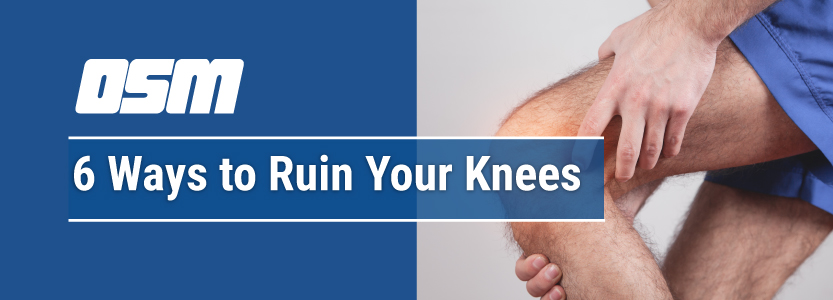6 Ways to Ruin Your Knees
Article featured on WebMD
Piplica had experienced some warning signs during her previous season of skating as captain of her team, but she ignored them for the most part. “I had tremendous pain in my leg anytime I’d squat down so I just kept my right leg straight. But I never saw a doctor for it. I just assumed, ‘I’m in a contact sport and this is what happens,’” she tells WebMD.
Knee deep: A complex and vulnerable joint
Her torn ACL diagnosis confirmed, Piplica quickly learned how susceptible the knees can be to injury. According to the American Academy of Orthopaedic Surgeons, these joints are responsible for sending nearly 15 million Americans to the doctor every year.
And it’s not just athletes who suffer. Knee problems can happen to anyone.
“Because they’re the main hinge between the ground and the rest of your body, the knees serve as your ‘wheels’ that get you around and allow you to be active,” says University of Pennsylvania orthopedic surgeon and sports medicine specialist Nicholas DiNubile, MD. “Life can really go downhill when you damage your knees,” says DiNubile, who is a spokesman for the American Academy of Orthopaedic Surgeons and author of FrameWork – Your 7-Step Program for Healthy Muscles, Bones and Joints.
Bound by an intricate system of ligaments, tendons, cartilage, and muscle, the knee is highly prone to injury. It’s a complex hinge where the femur (thigh bone), tibia (shin bone), fibula (next to tibia) and kneecap all come together.
1. Ignoring knee pain.
An occasional ache here and there is common. “But knowing when you can and can’t ignore pain is key,” says sports medicine specialist Jordan Metzl, MD, from the Hospital for Special Surgery in New York City.
Metzl’s rule of thumb: When the pain limits your ability to do what you normally do, you need to have it checked out.
“If your body is sending you signals, you need to listen to them. If they persist, you need to have it checked out,” he tells WebMD.
For Piplica, exploratory surgery revealed a torn meniscus she had endured in the past — unbeknownst to her — followed by the more recent ACL tear.
“In hindsight, maybe that first injury could have been repaired earlier, although I don’t know if I could have avoided this one altogether,” she says. “At least I would have been more careful.”
2. Being overweight.
Every pound of body weight yields five pounds of force on the knee, so even 10 extra pounds can put a considerable load on those joints.
Being overweight also increases your chances of osteoarthritis in the knee, a common and often disabling form of arthritis that wears away the knee’s cushiony cartilage. Excess pounds also cause existing arthritis to worsen more rapidly. According to the CDC, two out of three obese adults suffer from knee osteoarthritis at some time in their life.
Although diet and exercise are critical for weight loss, it’s a double-edged sword.
“If your knees hurt, it’s harder to lose weight through exercise,” says Metzl. So he recommends activities that go easy on the knee.
For example, opt for a stationary bike over running on the treadmill, and walk on a flat surface instead of hilly turf. If you’re a die-hard treadmill fan, then go for longer sessions of walking punched with brief intervals of brisk walking or running every three to five minutes, DiNubile says.
3. Not following through with rehab and rest.
The rest and rehabilitation period after a knee injury is critical to avoiding future pain or reinjury. Depending on the type of damage and treatment, recovery could last anywhere from a couple of weeks to several months.
4. Neglecting your ACL.
One of the most commonly injured ligaments in the knee, the anterior cruciate ligament (ACL) is responsible for about 150,000 injuries in the U.S. every year.
“Given what we know in how useful it can be in reducing ACL tears, it’s irresponsible of coaches and parents to not require athletes to undergo neuromuscular training,” says DiNubile.
He recommends that athletes of any age who play ACL risk-prone sports should seek help from an athletic trainer or other trained professional to help avoid this debilitating injury.
5. Overdoing it.
“You make gains in fitness when you work hard and then allow your body to recover. You can’t do a hard workout every day,” Metzl says.
As she awaits surgery to repair her torn ACL, Piplica tells WebMD that her perspective on long-term care for her knees has definitely changed.
“Half of me is frustrated about not being able to skate sooner, but the other half knows how important it is to get better so I don’t do this again. I’m 27 years old with a serious knee injury preventing me from moving around. So I need to look beyond just skating, skating, skating. I don’t want to have knee problems when I’m 40 or 50 because I’m not giving my body the kind of attention it needs right now.”
The Orthopedic & Sports Medicine Center of Oregon is an award-winning, board-certified orthopedic group located in downtown Portland Oregon. We utilize both surgical and nonsurgical means to treat musculoskeletal trauma, spine diseases, sports injuries, degenerative diseases, infections, tumors and congenital disorders.
Our mission is to return our patients back to pain-free mobility and full strength as quickly and painlessly as possible using both surgical and non-surgical orthopedic procedures.
Our expert physicians provide leading-edge, comprehensive care in the diagnosis and treatment of orthopedic conditions, including total joint replacement and sports medicine. We apply the latest state-of-the-art techniques in order to return our patients to their active lifestyle.
If you’re looking for compassionate, expert orthopedic surgeons in Portland Oregon, contact OSM today.
Phone:
503-224-8399
Address
17355 Lower Boones Ferry Rd Suite 100A
Lake Oswego, OR 97035
Hours
Monday–Friday
8:00am – 4:30pm



